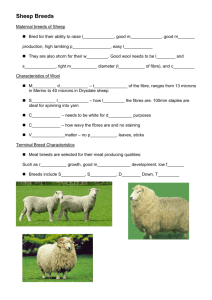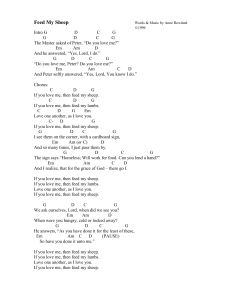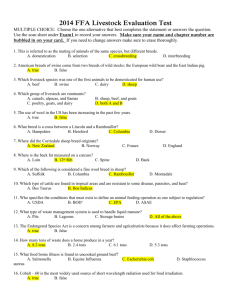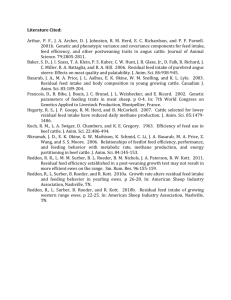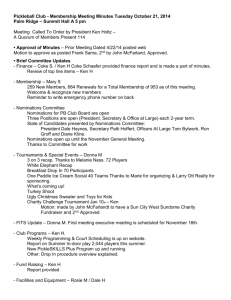Effects of Restricted Feeding on Intake, Digestion, Nitrogen Balance
advertisement
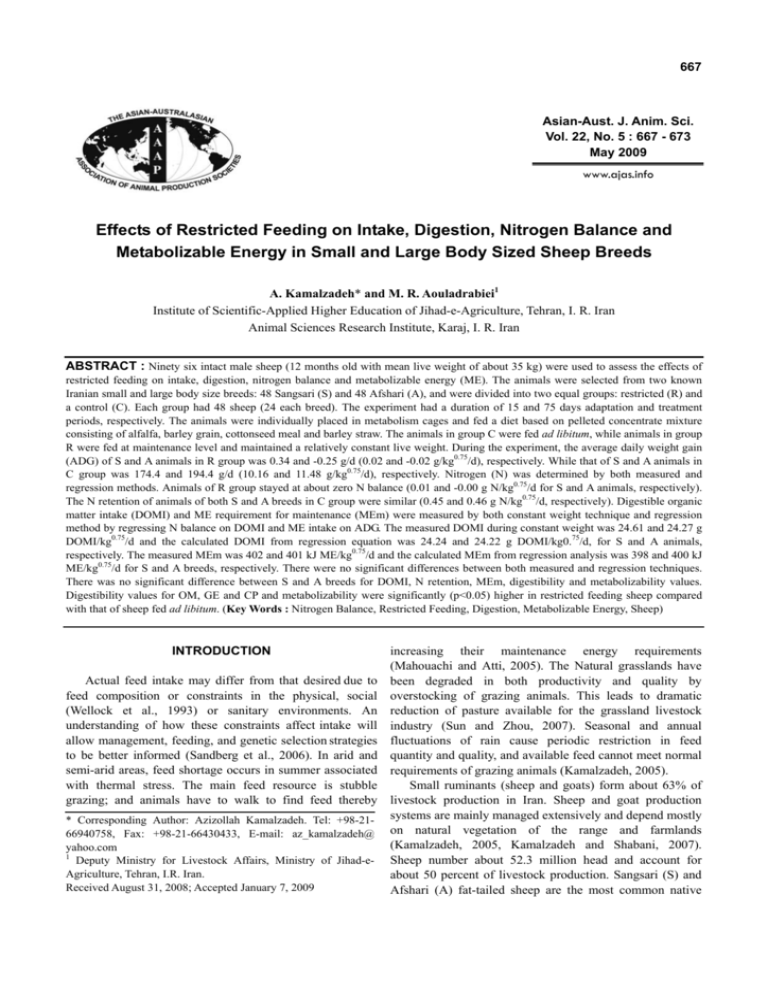
667 Asian-Aust. J. Anim. Sci. Vol. 22, No. 5 : 667 - 673 May 2009 www.ajas.info Effects of Restricted Feeding on Intake, Digestion, Nitrogen Balance and Metabolizable Energy in Small and Large Body Sized Sheep Breeds A. Kamalzadeh* and M. R. Aouladrabiei1 Institute of Scientific-Applied Higher Education of Jihad-e-Agriculture, Tehran, I. R. Iran Animal Sciences Research Institute, Karaj, I. R. Iran ABSTRACT : Ninety six intact male sheep (12 months old with mean live weight of about 35 kg) were used to assess the effects of restricted feeding on intake, digestion, nitrogen balance and metabolizable energy (ME). The animals were selected from two known Iranian small and large body size breeds: 48 Sangsari (S) and 48 Afshari (A), and were divided into two equal groups: restricted (R) and a control (C). Each group had 48 sheep (24 each breed). The experiment had a duration of 15 and 75 days adaptation and treatment periods, respectively. The animals were individually placed in metabolism cages and fed a diet based on pelleted concentrate mixture consisting of alfalfa, barley grain, cottonseed meal and barley straw. The animals in group C were fed ad libitum, while animals in group R were fed at maintenance level and maintained a relatively constant live weight. During the experiment, the average daily weight gain (ADG) of S and A animals in R group was 0.34 and -0.25 g/d (0.02 and -0.02 g/kg0.75/d), respectively. While that of S and A animals in C group was 174.4 and 194.4 g/d (10.16 and 11.48 g/kg0.75/d), respectively. Nitrogen (N) was determined by both measured and regression methods. Animals of R group stayed at about zero N balance (0.01 and -0.00 g N/kg0.75/d for S and A animals, respectively). The N retention of animals of both S and A breeds in C group were similar (0.45 and 0.46 g N/kg0.75/d, respectively). Digestible organic matter intake (DOMI) and ME requirement for maintenance (MEm) were measured by both constant weight technique and regression method by regressing N balance on DOMI and ME intake on ADG. The measured DOMI during constant weight was 24.61 and 24.27 g DOMI/kg0.75/d and the calculated DOMI from regression equation was 24.24 and 24.22 g DOMI/kg0.75/d, for S and A animals, respectively. The measured MEm was 402 and 401 kJ ME/kg0.75/d and the calculated MEm from regression analysis was 398 and 400 kJ ME/kg0.75/d for S and A breeds, respectively. There were no significant differences between both measured and regression techniques. There was no significant difference between S and A breeds for DOMI, N retention, MEm, digestibility and metabolizability values. Digestibility values for OM, GE and CP and metabolizability were significantly (p<0.05) higher in restricted feeding sheep compared with that of sheep fed ad libitum. (Key Words : Nitrogen Balance, Restricted Feeding, Digestion, Metabolizable Energy, Sheep) INTRODUCTION Actual feed intake may differ from that desired due to feed composition or constraints in the physical, social (Wellock et al., 1993) or sanitary environments. An understanding of how these constraints affect intake will allow management, feeding, and genetic selection strategies to be better informed (Sandberg et al., 2006). In arid and semi-arid areas, feed shortage occurs in summer associated with thermal stress. The main feed resource is stubble grazing; and animals have to walk to find feed thereby * Corresponding Author: Azizollah Kamalzadeh. Tel: +98-2166940758, Fax: +98-21-66430433, E-mail: az_kamalzadeh@ yahoo.com 1 Deputy Ministry for Livestock Affairs, Ministry of Jihad-eAgriculture, Tehran, I.R. Iran. Received August 31, 2008; Accepted January 7, 2009 increasing their maintenance energy requirements (Mahouachi and Atti, 2005). The Natural grasslands have been degraded in both productivity and quality by overstocking of grazing animals. This leads to dramatic reduction of pasture available for the grassland livestock industry (Sun and Zhou, 2007). Seasonal and annual fluctuations of rain cause periodic restriction in feed quantity and quality, and available feed cannot meet normal requirements of grazing animals (Kamalzadeh, 2005). Small ruminants (sheep and goats) form about 63% of livestock production in Iran. Sheep and goat production systems are mainly managed extensively and depend mostly on natural vegetation of the range and farmlands (Kamalzadeh, 2005, Kamalzadeh and Shabani, 2007). Sheep number about 52.3 million head and account for about 50 percent of livestock production. Sangsari (S) and Afshari (A) fat-tailed sheep are the most common native 668 Kamalzadeh and Aouladrabiei (2009) Asian-Aust. J. Anim. Sci. 22(5):667-673 Table 1. Dry matter (DM), organic matter (OM), gross energy (GE), crude protein (CP) and ash contents of the diet (g/ kg DM) Item Content DM (g/kg) 884 OM 902 GE 17.24 CP 131 Ash 98 breeds and with about 2.2 and 2.4 million head account for about 4.2 and 4.5% of the total sheep population, respectively. Afshari sheep are large in body size and the mature live weight of rams and ewes is about 88 and 70 kg, respectively. Sangsari sheep are small in body size and the mature live weight of rams and ewes is about 50 and 43 kg, respectively. Since data on energy and protein requirements of most Iranian sheep breeds are not available, the common feed allowance tables, such as those produced by Agricultural Research Council (ARC) and National Research Council (NRC), are being used to formulate diets. In general, the data used for the ARC and NRC common feed allowance tables are based upon the results of experiments in developed and temperate regions. These data may not be suitable for sheep production systems in arid and semi-arid areas. It has been shown that animals on restricted planes of nutrition have lower maintenance energy requirements (Ferrell et al., 1986). The energy required to maintain an animal at energy balance can be estimated from the relationship between energy intake and energy retention. Similarly, the digestible organic matter (DOM) required at zero weight gain and zero nitrogen retention can also be estimated from the relationship between intake of digestible organic matter (DOMI) and gain or nitrogen retention. Agricultural Research Council (1980) estimated a value of 420-450 kJ ME/kg0.75/d at zero energy retention and a value of 26 g DOMI/kg0.75/d at zero weight gain for growing sheep. However, after a period of weight stasis of 3 months, maintenance requirements of ME for weaned sheep were estimated to decrease to about 340 kJ ME/kg0.75/d (Graham and Searle, 1979), while the data derived from the study of Al-Jassim et al. (1996) on Iraqi Awassi sheep indicated a range of 350 to 490 kJ ME/kg0.75/d. Kamalzadeh (2004) also reported values of about 340 and 480 kJ ME/kg0.75/d for maintenance requirements of ME intake for growing Swifter lamb at zero energy balance and growth, respectively. Lower values of 300 kJ ME/kg0.75/d after a period of weight stasis of 4 to 6 months (Graham and Searle, 1975), and 266 kJ ME/kg0.75/d (Ryan, 1990) have also been reported for sheep. Thomson et al. (1982) observed that, during 144 days of mild feed restriction, restricted lambs showed significantly (p<0.05) higher digestibility value for crude protein (CP), while digestibility of dry matter (DM), gross energy (GE ) and metabolizability were higher but not significantly different to unrestricted lambs. It is expected that part of the large variation among the literature sources probably relates to estimation of the above values in breeds of different body sizes. Therefore, the present experiment was designed to measure the intake, nitrogen balance and ME requirements, digestibility values and metabolizability during restricted feeding (maintenance level) in small and large body size sheep breeds. MATERIALS AND METHODS Ninety six intact male sheep (12 months old with live weight of about 35 kg) were used. The animals were selected from two known Iranian small and large body size breeds; 48 Sangsari (S) and 48 Afshari (A) and were divided into two equal groups: restricted (R) and a control (C). Each group had 48 sheep (24 each breed). During the experiment, the animals were placed alternatively in metabolism cages and fed a pelleted concentrate mixture, consisting of 33% alfalfa, 28.5% barley grain, 13% barley straw, 20% cottonseed meal, 5% sugar beet molasses and 0.5% minerals and vitamin mixture. The DM content of the diet was 884 g per kg and was formulated to provide 17.24 MJ of GE and about 131 g CP per kg DM. The composition of the diet is presented in Table 1. The choice of a pelleted diet was to inhibit possible selectivity and waste and to accurately measure feed intake. At the onset of the experiment, all lambs were treated against gastrointestinal parasites. Animals were weighed weekly. The amount of feed offered was adjusted once every week, based on metabolic weight. During both adaptation and treatment periods, animals of group R were fed at a level adequate for maintaining constant weight and animals of group C were fed ad libitum to achieve their normal growth. Fresh water and salt licking blocks were freely available. Feeds were offered twice a day at 07.00 and 16.00 h. The quantity of feeds offered and refused by individual lambs was recorded daily. Refusals were removed and weighed before the morning feeding. Environmental temperature was kept constant at approximately 20°C. Relative humidity was maintained at approximately 50%. A lighting regime was imposed of 12 h/12 h day/night to avoid seasonal effect of day length. The experiment consisted of a 15 day adaptation period followed by three consecutive 25 day balance trials. Each balance trial consisted of a preliminary period of 15 days and a collection period of 10 days. During each collection period, representative samples were taken of the feed offered. Daily feed intake for each lamb was recorded. The feed refusal, faeces and urine of each lamb were collected and weighed daily, pooled over each collection period and representative samples were taken and retained for Kamalzadeh and Aouladrabiei (2009) Asian-Aust. J. Anim. Sci. 22(5):667-673 669 Table 2. Means and standard errors of live weight, intake of dry matter (DM), organic matter (OM), digestible organic matter (DOM) and nitrogen (N), N losses in faeces and urine, N balance, and daily weight gain of Sangsari (S) and Afshari (A) breeds in control (C) and feed-restricted (R) groups C R Breed S A S A Live-weight (kg) Initial 34.58a±0.30 35.18a±0.14 34.85a±0.39 35.26a±0.05 a a b Final 52.09 ±0.26 35.20 ±0.14 34.83b±0.41 50.96 ±0.12 0.75 Intake (g/kg /d) DM 84.42a±0.49 40.83b±0.47 40.68b±0.21 84.00a±0.62 a a b OM 76.13 ±0.44 36.83 ±0.40 36.69b±0.19 75.79 ±0.62 a a b DOM 49.09 ±0.28 24.61 ±0.25 24.27b±0.29 47.45 ±0.33 a a b N 1.77 ±0.01 0.86 ±0.01 0.85b±0.004 1.76 ±0.01 0.75 N losses (g/kg /d) Faeces 0.73a±0.02 0.73a±0.02 0.30b±0.03 0.32b±0.01 a a a Urine 0.59 ±0.02 0.56 ±0.04 0.53a±0.01 0.58 ±0.01 0.75 a a b N balance (g/kg /d) 0.46 ±0.01 0.005 ±0.01 -0.00b±0.01 0.45 ±0.01 a a b Gain (g/d) 194.4 ±2.03 0.34 ±1.21 -0.25b±1.75 174.4 ±1.48 0.75 a a b Gain (g/kg /d) 10.16 ±0.08 11.48 ±0.14 0.02 ±0.08 -0.02b±0.12 a, b Values within line with different superscripts differ significantly (p<0.001). subsequent chemical analyses. A small amount of 30% formalin was added to the faeces container for preservation. Before collection of urine, one litre of water acidified by 20 ml (6N) HCL was put in the collection bucket, to prevent evaporation of ammonia. The collected samples of feed, refusals and faeces were analyzed for DM, ash, N and energy contents. Urine was analyzed for N and energy contents. Samples of feed offered and refused, and of faeces were dried at 50°C until they attained a constant weight before chemical analyses. The DM content of the feed offered and refused and of faeces was determined by drying representative subsamples to constant weight at 103°C, while OM was calculated as weight loss of the same sub-samples during ashing at 550°C for 3 h. The N content of the feeds, refusals, faeces and urine was determined according to the Kjeldahl method (AOAC, 1989). Live weight (kg) 55 GE content was determined using an adiabatic bomb calorimeter. Digestible energy (DE) and ME intake per lamb were determined from the energy content of feed eaten and the amount of energy lost through faeces, urine and methane. The amount of energy loss through methane was set at 7% of the GE intake (CSIRO, 2001; Kamalzadeh, 2004). Digestibility of OM was defined as the ratio of DOMI and OMI. The ratio of DE and GE and the ratio of digestible CP and CP intake was used to define GE and CP digestibility, respectively. Data were subjected to analysis of variance (Steel and Torrie, 1982), and comparisons between group and breed means were made using Student t-test. Prediction equations were derived by regression linear models. The combined data of both C and R groups were used to estimate the requirements. Weekly data of live weight and the average data of other measurements in 3 balance trials were used. RESULTS 50 45 40 35 30 50 52 54 56 58 60 62 64 66 Age (week) Figure 1. Relationship between live weight (kg) and age (week), for control (C) animals (Sangsari () and Afshari (▲) breeds), and feed-restricted (R) animals (Sangsari () and Afshari (∆) breeds). Animals on restricted feeding level had a significantly (p<0.001) lower whole diet organic matter intake (OMI), digestible organic matter intake (DOMI) and nitrogen intake (NI), and maintained a relatively constant live weight (Table 2). During the experiment, the ADG of S and A animals in R group was 0.34 and -0.25 g/d (0.02 and -0.02 g/kg0.75/d), respectively, while that of S and A animals in C group was 174.4 and 194.4 g/d (10.16 and 11.48 g/kg0.75/d), respectively. The pattern of live weight change during the experiment is shown in Figure 1. The animals of S breed approached their mature live weight at about 50 kg. The trend also showed that ADG of animals in S breed decreased faster after about 45 kg live weight (Figure 2). 670 Kamalzadeh and Aouladrabiei (2009) Asian-Aust. J. Anim. Sci. 22(5):667-673 ADG (g/kg0.75/d) N balance (g/kg0.75/d) 0.6 0.5 0.4 0.3 0.2 0.1 0 -0.1 20 Weeks Figure 2. Average daily weight gain (ADG) (g/kg0.75/d) of control (C) animals (Sangsari () and Afshari (▲) breeds), and feedrestricted (R) animals (Sangsari () and Afshari (∆) breeds) during experiment. 25 30 35 DOMI 40 45 50 55 (g/kg0.75/d) Figure 3. Relationship between N balance (g/kg0.75/d) and digestible organic matter intake (DOMI) (g/kg0.75/d), combined data of both C (Sangsari () and Afshari (▲) breeds) and R (Sangsari () and Afshari (∆) breeds) animals. Lines (–) and (---) -present the predicted values for S and A breeds, respectively. The average daily intake was 84, 84.42 and 40.83, 40.68 g DM/kg0.75/d for S and A animals in C and R groups, Y(A) = -0.45(0.01)+0.02(0.00)×X, respectively (Table 2). The pattern of daily intake was (n = 48 and R2 = 0.98) similar for animals of both S and A breeds in C and R in which: Y = N balance (g/kg0.75/d) groups. X = DOMI (g/kg0.75/d) Animals of R group stayed at about zero N balance 0.75 (0.01 and -0.00 g N/kg /d for S and A animals, The regression of ADG on DOMI suggested a zero respectively). The N retention of animals of both S and A 0.75 ADG at 24.39 and 24.17 g DOMI/kg0.75/d for S and A breeds in C group were similar (0.45 and 0.46 g N/kg /d, respectively). Faecal nitrogen loss was lower (p<0.001) in animals, respectively. The derived regression equations R animals. The measured DOMI during constant weight were: was 24.61 and 24.27 g DOMI/kg0.75/d, for S and A animals, Y(S) = -10.68(0.33)+0.44(0.01)×X, respectively (Table 2). (n = 48 and R2 = 0.98) The regression equation of N balance on DOMI estimated a zero N balance at 24.24 and 24.22 g Y(A) = -11.36(0.39)+0.47(0.01)×X, DOMI/kg0.75/d for S and A animals, respectively (Figure 3). The following equations were found: (n = 48 and R2 = 0.98) Y(S) = -0.47(0.02)+0.02(0.00)×X, (n = 48 and R2 = 0.97) in which: Y = ADG (g/kg0.75/d) X = DOMI (g kg0.75/d) Table 3. Means and standard errors of live weight, intake of gross energy (GE), digestible energy (DE), metabolizable energy (ME), and energy losses of Sangsari (S) and Afshari (A) breeds in control (C) and feed-restricted (R) groups C R Breed S A S A Live-weight (kg) Initial 35.26a±0.05 34.58a±0.30 35.18a±0.14 34.85a±0.39 a a b Final 50.96 ±0.12 52.09 ±0.26 35.20 ±0.14 34.83b±0.41 0.75 Energy intake (kJ/kg /d) GE 1448a±10.77 1455a±8.43 704b±8.12 701b±3.65 a a b DE 896 ±4.79 904 ±4.99 481 ±5.84 475b±3.34 a a b ME 746 ±4.29 402 ±5.24 401b±3.05 741 ±4.79 0.75 Energy losses (kJ/kg /d) Faeces 551a±5.80 223b±4.46 226b±2.27 553a±11.37 a a b Urine 55.8 ±0.69 29.5 ±0.81 25.4b±0.34 52.83 ±0.63 a a b Methane 101.9 ±0.59 49.3 ±0.57 49.1b±0.26 101.4 ±0.75 a, b Values within line with different superscripts differ significantly (p<0.001). Kamalzadeh and Aouladrabiei (2009) Asian-Aust. J. Anim. Sci. 22(5):667-673 671 Table 4. Means and standard errors of digestibilities, metabolizability and content of metabolizable energy in digestible energy (ME/DE) of Sangsari (S) and Afshari (A) breeds in control (C) and feed- restricted (R) groups C R Breed S A S A Digestibilities (%) OM 62.7a±0.39 63.6a±0.41 66.9b±0.48 66.1b±0.67 a a b GE 61.9 ±0.005 62.1 ±0.003 68.3 ±0.005 67.7b±0.003 a a b CP 58.7 ±0.01 59 ±0.01 65.0 ±0.95 62.2b±0.01 Metabolizability (%) 51.3a±0.005 51.3a±0.002 57.2b±0.004 57.1b±0.003 a a a ME/DE 82.8 ±0.15 82.6 ±0.085 83.6 ±0.17 84.3a±0.09 a, b Values within line with different superscripts differ significantly (p<0.05). The energy intake of restricted animals decreased (p< 0.001). The measured MEm was 402 and 401 kJ ME/kg0.75/d for S and A breeds, respectively (Table 3). Energy losses through faeces, urine and methane significantly (p<0.001) decreased in feed restricted animals compared with C animals. The estimated ME required for maintenance (zero growth) was 398 and 400 kJ ME/kg0.75/d for S and A animals, respectively. The derived regression equations were: Y(S) = -11.67(0.40)+0.03(0.00)×X (n = 48 and R2 = 0.98) Y (A) = -13.18(0.37)+0.03(0.00)×X (n = 48 and R2 = 0.98) in which: Y = ADG (g/kg0.75/d) X = ME (kJ/kg0.75/d) The digestibility, metabolizability and the content of metabolizable energy in the digestible energy (ME/DE) are shown in Table 4. Digestibility of OM, GE and CP and metabolizability in the R group improved and were significantly higher (p<0.05) compared with the C group. Metabolizable energy (ME) content of the diet for C and R animals was 82.8 and 83.6% and 82.6 and 84.3% of digestible energy (DE) in S and A breeds, respectively. DISCUSSION Usually, under restricted feeding no weight gain is possible and maintenance energy requirements decrease. Maintenance requirements of restricted animals can be reduced to a level that approaches their basal metabolic rate (Ryan, 1990; Kamalzadeh et al., 1997). The results presented demonstrate that efficiency of feed utilization and the amount of feed required for maintaining live weight were influenced by plane of nutrition. These findings suggest that feed required for maintaining body weight is not a constant function of body weight but may be altered by plane of nutrition. These observations are supported by several reports including those of Graham and Searle (1975), Ferrell et al. (1986) and Kamalzadeh (2004) which have shown that maintenance requirements decrease in response to low levels of feed intake. There was no significant difference between values for DOMI in both measured and regression methods. These values are considerably lower than the maintenance energy requirements of 26 g DOMI/kg0.75/d (ARC, 1980), 29.7 g DOMI/kg0.75/d (Oosting et al., 1995), and 26.4 g DOMI/kg0.75/d (Ketelaars and Tolkamp, 1991) at zero N balance in sheep. During the maintenance feeding, the regression of ADG on DOMI also suggested a zero ADG at 24.39 and 24.17 g DOMI/kg0.75/d for S and A breeds, respectively. These values are lower than the generalized range (25-30 g/kg0.75/d) reported by ARC (1980) and Oosting et al. (1995) for sheep at zero ADG. A value of 22.1 g DOMI/kg0.75/d was also reported for sheep (Kamalzadeh et al., 1997), which might be due to imposing a relatively severe feed quality restriction for a period of 3 months. The results of this experiment indicate that animals may decrease their maintenance requirements as a result of feed restriction. Most likely, during a period of weight stasis, sheep are able to maintain N balance beyond the level of DOMI where weight gain is zero. When the ME intake was regressed on ADG, the estimated ME requirement for maintenance was 398 and 400 kJ ME/kg0.75/d for S and A breed, respectively. There was no significant difference between S and A breeds. These findings are supported by several reports including those of Mohammad et al. (1989) and Al-Jassim et al. (1996). Values derived from studies of Mohammad et al. (1989) and Al-Jassim et al. (1996) on Iraqi Awassi sheep ranged between 350 to 490 kJ ME/kg0.75/d. Thomson et al. (1986) also estimated a range of 369 to 373 kJ ME/kg0.75/d. However, Graham and Searle (1979) and Kamalzadeh (2004) reported a value of 340 kJ ME/kg0.75/d for Merino and Swifter sheep after a relatively severe (below maintenance) period of 3 months feed restriction. Lower values of 300 kJ ME/kg0.75/d after a period of weight stasis of 4 to 6 months (Graham and Searle, 1975), 275 kJ 672 Kamalzadeh and Aouladrabiei (2009) Asian-Aust. J. Anim. Sci. 22(5):667-673 ME/kg0.75/d (Gingins et al., 1980) and 266 kJ ME/kg0.75/d (Ryan, 1990) have also been reported for sheep. These findings are not supported by the results of this study. It seems that the low values reported above resulted when the duration and or severity of restricted feeding were increased. ARC (1980) also suggested a range of 420-450 kJ ME/kg0.75/d for sheep fed ad libitum. It seems that the generalized range proposed by ARC is higher than the actual requirements of sheep breeds used in this experiment. The variations between the above reports probably relate to estimation of the values in different experimental conditions. Relative to metabolic weight, energy losses through faeces, urine and methane were decreased in feed-restricted animals. This was mainly caused by a low level of N intake and decreased N excretion through faeces. Al-Mamun et al. (2007) also reported lower N intake and N excretion through faeces in feed-restricted sheep. The digestibility values observed in the present experiment are similar to earlier reports of Zemmelink et al. (1991), Oosting et al. (1995), Hirayama and Katoh (2004) and Assoumaya et al. (2009). A higher (p<0.05) digestibility of OM, GE and CP, and metabolizability occurred in feedrestricted animals compared to controls. An improvement in the digestibilities and metabolizability in feed-restricted compared to control sheep has been also noted by Thomson et al. (1982). Normally, digestibilities and metabolizability improve during restricted feed intake. This is probably due to an increased efficiency of feed utilization as a result of decreased rumen feed passage. The metabolizability values obtained in this experiment were between 51.3 and 57.1%. These results are in the range (40 to 64%) proposed in several reports including those of ARC (1980), Thomson et al. (1982), Oosting et al. (1995) and Kamalzadeh (2004). The ME content in the DE (ME/DE) was slightly, although not significantly (p>0.05) higher in R animals compared with C animals. In general, the content of ME of the diet was between 82.6 and 84.3% of DE in both C and R animals. Gingins et al. (1980) and Thamson et al. (1982) found similar results. These values are slightly, but not significantly (p>0.05) above the generalized value of 82% recommended by ARC (1980). The differences in digestibilities, metabolizability and ME/DE values between S and A breeds were not significant (p>0.05). CONCLUSIONS The results presented in this experiment indicate that during restricted feeding, sheep can decrease maintenance requirements as a result of feed restriction. Part of the large variation in maintenance requirements of sheep among literature sources probably relates to estimation of the values in different experimental conditions. It seems that the experimental conditions (length and severity of feed restriction, type of diet used, and environmental conditions) are more important than breed body size. It seems that the generalized maintenance requirements values recommended in common feed allowance tables such as ARC do not fit well to the sheep breeds used in this experiment. ACKNOWLEDGMENT The authors are grateful to the Iranian National Scientific and Researches Committee, and National Animal Science and Research Institute for financial and technical support and also to the Agriculture Research Centres of Semnan and Khorasan Razavi provinces for conducting the trial. REFERENCES Agricultural Research Council (ARC) 1980. The nutrient requirements of ruminant livestock. Commonwealth Agricultural Bureaux, Farnham Royal, England. Al Jassim, R. A. M., S. A. Hassan and A. N. Al-Ani. 1996. Metabolizable energy requirements for maintenance and growth of Awassi lambs. Small Rum. Res. 20:239-245. Al-Mamun, M., C. Ito, A. Sato, T. Fujita and H. Sano. 2007. Comparison of the [2H5]phenylalanine model with the [113 C]leucine method to determine whole body protein synthesis and degradation in sheep fed at two levels. Asian-Aust. J. Anim. Sci. 20(10):1517-1524. AOAC. 1989. Official methods of analysis (14th edition). Association of Official Analytical Chemists, Arlington, VA, pp. 152-157. Assoumaya, C., D. Sauvant, F. Pommier, M. Boval, B. Calif and H. Archimède. 2009. Effect of frequency of meals on intake and digestion of tropical grass consumed by rams. Asian-Aust. J. Anim. Sci. 22(1):72-81. CSIRO. 2001. Testing sheep for methane production. Science image, CSIRO Division, GA 1334. Ferrell, C. L., L. J. Koong and J. A. Nienaber. 1986. Effect of previous nutrition on body composition and maintenance energy costs of growing lambs. Br. J. Nutr. 56:595-605. Gingins, M., H. Bickel and A. Schurch. 1980. Efficiency of energy utilization in undernourished and realimented sheep. Livest. Prod. Sci. 7:465-471. Graham, N. McC. and T. W. Searle. 1975. Studies of weaner sheep during and after a period of weight stasis. I. Energy and nitrogen utilization. Aust. J. Agric. Res. 26:343-354. Graham, N. McC. and T. W. Searle. 1979. Studies of weaned lambs before, during and after a period of weight loss. I. Energy and nitrogen utilization. Aust. J. Agric. Res. 30:513523. Hirayama, T. and K. Katoh. 2004. Effects of heat exposure and restricted feeding on behavior, digestibility and growth hormone secretion in goats. Asian-Aust. J. Anim. Sci. 17(5):655-658. Kamalzadeh, A. 2004. Energy and nitrogen metabolism in lambs Kamalzadeh and Aouladrabiei (2009) Asian-Aust. J. Anim. Sci. 22(5):667-673 during feed restriction and realimentation. J. Agric. Sci. Tech. 6:21-30. Kamalzadeh, A. 2005. Modeling the productivity of a breeding sheep flock for different production systems. Asian-Aust. J. Anim. Sci. 18(5):606-612. Kamalzadeh, A. and A. Shabani. 2007. Maintenance and growth requirements for energy and nitrogen of Baluchi sheep. Inter J. Agric. Biol. 9(4):535-539. Kamalzadeh, A., J. Van Bruchem, W. J. Koops, S. Tamminga and D. Zwart. 1997. Feed quality restriction and compensatory growth in growing sheep: feed intake, digestion, nitrogen balance and modelling changes in feed efficiency. Livest. Prod. Sci. 52:209-217. Ketelaars, J. J. M. H. and B. J. Tolkamp. 1991. Toward a new theory of feed intake regulation in ruminants. PhD thesis, Agricultural University, Wageningen, The Netherlands. Mahouachi, M. and N. Atti. 2005. Effects of restricted feeding and re-feeding of Barbarine lambs: intake, growth and non-carcass components. Anim. Sci. 81:305-312. Mohammad, H. H., A. S. Ahmad and E. D. Salman. 1989. Determination of maintenance energy requirement of Awassi sheep. Proc. 5th Scientific Conference, Science Research Council, Baghdad, p. 176. 673 Oosting, S. J., J. Van Bruchem and X. B. Chen. 1995. Intake, digestion and small intestine protein availability in sheep in relation to ammoniation of wheat-straw with or without protein supplementation. Br. J. Nutr. 74:347-368. Ryan, W. J. 1990. Compensatory growth in cattle and sheep. Nutr. Abs. Rev. Ser. B, 60:653-664. Sandberg, F. B., G. C. Emmans and I. Kyriazakis. 2006. A model for predicting feed intake of growing animals during exposure to pathogens. J. Anim. Sci. 84:1552-1566. Steel, R. G. D. and J. H. Torrie. 1982. Principles and procedures of statistics. A Biometric Approach. 2nd Edition. McGraw-Hill, New York, pp. 139-145. Sun, H. X. and W. Zhou. 2007. Seasonal changes in voluntary intake and digestibility by sheep grazing introduced Leymus chinensis pasture. Asian-Aust. J. Anim. Sci. 20(6):872-879. Thomson, E. F., H. Bickel and A. Schürch. 1982. Growth performance and metabolic changes in lambs and steers after mild nutritional restriction. J. Agric. Sci. Camb. 98:183-194. Wellock, I. J., G. C. Emmans and I. Kyriazakis. 2003. Predicting the consequences of social stresses on pig feed intake and performance. J. Anim. Sci. 81:2995-3007. Zemmelink, G., B. J. Tolkamp and N. W. M. Ogink. 1991. Energy requirements for maintenance and gain of West African Dwarf goats. Small Rum. Res. 5:205-215.

